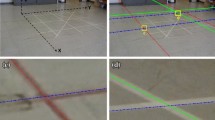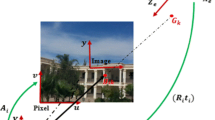Abstract
In this paper we describe the theory and practice of self-calibration of cameras which are fixed in location and may freely rotate while changing their internal parameters by zooming. The basis of our approach is to make use of the so-called infinite homography constraint which relates the unknown calibration matrices to the computed inter-image homographies. In order for the calibration to be possible some constraints must be placed on the internal parameters of the camera.
We present various self-calibration methods. First an iterative non-linear method is described which is very versatile in terms of the constraints that may be imposed on the camera calibration: each of the camera parameters may be assumed to be known, constant throughout the sequence but unknown, or free to vary. Secondly, we describe a fast linear method which works under the minimal assumption of zero camera skew or the more restrictive conditions of square pixels (zero skew and known aspect ratio) or known principal point. We show experimental results on both synthetic and real image sequences (where ground truth data was available) to assess the accuracy and the stability of the algorithms and to compare the result of applying different constraints on the camera parameters. We also derive an optimal Maximum Likelihood estimator for the calibration and the motion parameters. Prior knowledge about the distribution of the estimated parameters (such as the location of the principal point) may also be incorporated via Maximum a Posteriori estimation.
We then identify some near-ambiguities that arise under rotational motions showing that coupled changes of certain parameters are barely observable making them indistinguishable. Finally we study the negative effect of radial distortion in the self-calibration process and point out some possible solutions to it.
Similar content being viewed by others
References
Agapito, L., Hartley, R.I., and Hayman, E. 1999. Linear calibration of a rotating and zooming camera. In Proc.IEEE Conference on Computer Vision and Pattern Recognition, Fort Collins, Colorado, pp. 15–21.
Agapito, L., Hayman, E., and Reid, I. 1998. Self-calibration of a rotating camera with varying intrinsic parameters. In Proc.9th British Machine Vision Conference, Southampton, pp. 105–114.
Agapito, L., Reid, I., Hayman, E., and Hartley, R. 2001. Selfcalibration of zooming cameras from a single viewpoint: Application to panoramic mosaicing. In Panoramic Vision, R. Benosman and S.B. Kang (Eds.). Springer-Verlag, Berlin.
Capel, D. and Zisserman, A. 1998. Automated mosaicing with superresolution zoom. In Proc.IEEE Conference on Computer Vision and Pattern Recognition, Santa Barbara, pp. 885–891.
Faugeras, O.D., Luong, Q., and Maybank, S. 1992. Camera selfcalibration: Theory and experiments. In Proc.European Conference on Computer Vision. Springer-Verlag, Berlin, pp. 321–334.
Hartley, R.I. 1993. Euclidean reconstruction from uncalibrated views. In Proc.2nd European-US Workshop on Invariance, J.L. Mundy, A. Zisserman, and D. Forsyth (Eds.). Azores, pp. 187–202.
Hartley, R.I. 1994. Self-Calibration from Multiple Views with a Rotating Camera. In Proc.3rd European Conference on Computer Vision, Vol. 1, Stockholm, pp. 471–478.
Hartley, R.I. 1997. Self-calibration of Stationary Cameras. International Journal of Computer Vision, 22(1):5–23.
Hartley, R.I., Hayman, E., de Agapito, L., and Reid, I.D. 1999. Camera calibration and the search for infinity. In Proc.7th International Conference on Computer Vision, Kerkyra, Greece, pp. 510–517.
Hayman, E. 2000. The use of zoom within active vision. Ph.D. Thesis, University of Oxford. Available at http://www.robots.ox. ac.uk/ActiveVision/Papers/... HaymanDPhil2000.
Hayman, E., de Agapito, L., Reid, I.D., and Murray, D.W. 2000.
The rôle of self-calibration in euclidean reconstruction from two Self-Calibration of Rotating and Zooming Cameras 127 rotating and zooming cameras. In Proc.6th European Conference on Computer Vision, Dublin, Ireland, pp. 477–492.
Heyden, A. and Åström, K. 1997. Euclidean reconstruction from image sequences with varying and unknown focal length and principal point. In Proc.IEEE Conference on Computer Vision and Pattern Recognition, pp. 438–443.
Heyden, A. and Åström, K. 1998. Minimal conditions on intrinsic parameters for Euclidean reconstruction. In Proc.Asian Conference on Computer Vision.
Heyden, A. and Åström, K. 1999. Flexible calibration: Minimal cases for auto-calibration. In Proc.7th International Conference on Computer Vision, Kerkyra, Greece, pp. 350–355.
Heyden, A. and Åström, K. 1996. Euclidean reconstruction from constant intrinsic parameters. In Proc.International Conference on Pattern Recognition.
Kahl, F. 1999. Critical motions and ambiguous Euclidean reconstructions in auto-calibration. In Proc.7th International Conference on Computer Vision, Kerkyra, Greece, pp. 469–475.
Kahl, F., Triggs, B., and Åström, K. 2000. Critical motions for autocalibration when some intrinsic parameters can vary. Journal of Mathematical Imaging and Vision, 13(2):131–146.
Liebowitz, D. and Zisserman, A. 1998. Metric rectification for perspective images of planes. In Proc.IEEE Conference on Computer Vision and Pattern Recognition, pp. 482–488.
Luong, Q.T. and Viéville, T. 1996. Canonical representations for the geometries of multiple projective views. Computer Vision and Image Understanding, 64(2):193–229.
Moons, T., van Gool, L., van Diest, M., and Oosterlinck, A. 1993. Affine structure from perspective image pairs under relative translations between object and camera. Technical Report KUL/ESAT/M12/9306, Departement Elektrotechniek, Katholieke Universiteit Leuven, Belgium.
Pollefeys, M. 1999. Self-calibration and metric 3D reconstruction from uncalibrated image sequences. Ph.D. Thesis, ESAT-PSI, K.U. Leuven.
Pollefeys, M., Koch, R., and Van Gool, L. 1998. Self calibration and metric reconstruction in spite of varying and unknown internal camera parameters. In Proc.6th International Conference on Computer Vision, Bombay, India, pp. 90–96.
Sawhney, H., Hsu, S., and Kumar, R. 1998. Robust video mosaicing through topology inference and local to global alignment. In Proc.5th European Conference on Computer Vision, Freiburg, Germany, pp. 103–119.
Sawhney, H. and Kumar, R. 1999. True multi-image alignment and its application to mosaicing and lens distortion correction. IEEE Transactions on Pattern Analysis and Machine Intelligence, 21(3):245–243.
Seo, Y. and Hong, K. 1998. Auto-calibration of a rotating and zooming camera. In Proc.of IAPR workshop on Machine Vision Applications, Chiba, Japan, pp. 17–19.
Seo, Y. and Hong, K. 1999. About the self-calibration of a rotating and zooming camera: Theory and practice. In Proc.7th International Conference on Computer Vision, Kerkyra, Greece, pp. 183–189.
Sharkey, P.M., Murray, D.W., Vandevelde, S., Reid, I.D., and McLauchlan, P.F. 1993. A modular head/eye platform for realtime reactive vision. Mechatronics, 3(4):517–535.
Sturm, P. 1997. Critical motion sequences for monocular selfcalibration and uncalibrated euclidean reconstruction. In Proc.IEEE Conference on Computer Vision and Pattern Recognition, pp. 1100–1105.
Sturm, P. 1999. Critical motion sequences for the self-calibration of cameras and stereo systems with variable focal length. In Proc.10th British Machine Vision Conference, Nottingham.
Sturm, P. and Maybank, S. 1999. On plane based camera calibration: A general algorithm, singularities, applications. In Proc.IEEE Conference on ComputerVision andPattern Recognition, pp. 432–437.
Szeliski, R. and Shum, H. 1997. Creating full view panoramic image mosaics and environment maps. In Proceedings of the ACM SIGGRAPH Conference on Computer Graphics, pp. 251–258.
Tordoff, B.J. and Murray, D.W. 2000. Violating rotating camera geometry: The effect of radial distortion on self-calibration. In Proc.International Conference on Pattern Recognition.
Triggs, B. 1998. Autocalibration from planar scenes. In Proc.5th European Conference on Computer Vision, Freiburg, Germany.
Triggs, W. 1997. Auto-calibration and the absolute quadric. In Proc.IEEE Conference on Computer Vision and Pattern Recognition, Puerto Rico, pp. 609–614.
Tsai, R. and Lenz, R. 1989. A new technique for fully autonomous and efficient 3D robotics hand/eye calibration. IEEE Trans.Robotics and Automation, 5(3):345–358.
Zhang, Z. 1999. A flexible new technique for camera calibration. In Proc.7th International Conference on Computer Vision, Kerkyra, Greece.
Zisserman, A., Liebowitz, D., and Armstrong, M. 1998. Resolving ambiguities in auto-calibration. Philosophical Transactions of the Royal Society of London, SERIES A, 356(1740):1193–1211.
Author information
Authors and Affiliations
Additional information
An erratum to this article can be found at http://dx.doi.org/10.1023/A:1014514429063
Rights and permissions
About this article
Cite this article
Agapito, L., Hayman, E. & Reid, I. Self-Calibration of Rotating and Zooming Cameras. International Journal of Computer Vision 45, 107–127 (2001). https://doi.org/10.1023/A:1012471930694
Issue Date:
DOI: https://doi.org/10.1023/A:1012471930694




